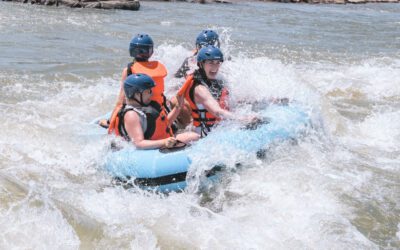In the Disney animated classic Dumbo, the song “Pink Elephants” tells the tale of having raised one too many glasses and afterward being visited by dancing visions of pastel-colored pachyderms.
Thinking one is seeing a herd of elephants roaming the plains of Oklahoma may suggest a similar hallucinogenic effect has been induced. Or it might just be a trip to the Endangered Ark Foundation, one of the most unique animal attractions in the country.
“They are very social creatures,” says Executive Director Karyn Olmos of the foundation’s regal main attractions. “They are a matriarchal society, so women and young elephants live together. The older mature elephants are separated.
“Just like us, they all have different personalities that mesh with other personalities. You can parallel them to your average human family; there’s days where you absolutely love your family and you will fight to the death for your family, but there’s some days personalities clash.”
In all, the foundation’s two hundred acres are home to sixteen Asian elephants, a quarter of which were born here, the rest are retired from circus life. These adult creatures range in size from seven thousand to eight thousand pounds on up to the largest female and male specimens at ten thousand and fourteen thousand pounds, respectively.
The animals are cared for by a full-time staff of eleven and viewed by about fifty thousand visitors to the park and its programs every year.
“We have our public and private tours. Our private tours are a little more geared towards just you as the guest with the animals. We’re doing a lot of education there,” says Karyn. “Almost always, people can feed and get up close to the elephants. It’s very safe. They’re very enticed by food! Elephants eat almost all day long, so they enjoy getting special treats like vegetables from our guests.
“We also have our cabin experiences where guests stay onsite, and the elephants come up to your cabin in the morning and visit you. It’s a very special moment. Guests get to feed and interact with an elephant at that time.”
The foundation also supports various special programs that aim directly at educating the public on the challenges faced by the majestic creatures in the wild.
“We have a summer camp for youth ages nine to fourteen,” Karyn says. “It is an overnight camp where they learn all about the endangered Asian elephant. It’s about conservation and leadership and they learn so much during camp.
“Then we also have special events such as elephant bathing. We have a special spa experience where guests get to bathe the elephants, which they really love. It’s a very gentle scrubbing, not like the typical bathing that our crew does. It’s kind of a spa day for them.”
The foundation was created by circus operators D.R. and Isla Miller in 1993 as a way to help educate the public on the need to preserve the endangered Asian elephant. Per the organization, there are only about 35,000 to 45,000 Asian elephants left on Earth. Of these, a mere handful reside in North America, yet the plight of the Asian variety tends to be overshadowed by their big-eared cousins.
“When it comes to elephants, people tend to definitely focus on the big African elephants,” Karyn says. “Most people think about endangered elephants as it relates to ivory. For African elephants, the issue is poaching, and it’s been horrible. The African government has come in and done a lot of things to really crack down on poachers.
“For Asian elephants, the issue is deforestation, it’s habitat loss. People are infringing on where they live. They don’t have places to get water and food, they’re migrating and they’re starving.”
The foundation is ready and willing to take in additional elephants, but such is not likely because in the United States elephants are already in good hands, Karyn says. That, plus a ban on the import and export of the species – a byproduct of their being endangered – means the herd must grow the old-fashioned way.
“I think the main difference between breeding here and breeding in the wild is that it is a more controlled environment,” Karyn says. “It’s consciously done, starting with drawing bloodwork to see when they’re cycling. They have very small windows for when that happens. Having babies is not necessarily harder. There’s a smaller pool of elephants so anytime it happens it’s kind of a miracle and something wonderful.”
As for any big bundles of joy on the way right now, Karyn shrugs and smiles.
“Not that we know of,” she says. “But it is a twenty-two-month gestation, so we’ll see.”
One thing that’s not in doubt is the time and resources it takes to maintain an elephant throughout its lifetime.
“Roughly, one elephant is pretty much the cost of about a family of four for a year. That’s food, care, nothing too extreme,” Karyn says. “People are usually surprised at the life expectancy of an elephant, which is a very long life. They can live into their seventies with the highest record-breakers in their later eighties.
“Obviously, there are elephants that need special treatment and care, especially as they get older. And as inflation rises, obviously, prices increase, and costs go up.”
That reality keeps the foundation on its toes to come up with new ways to educate the public about their elephants and inspire contributions for their care and upkeep. A few sponsorship opportunities are available through the foundation’s website including the chance to “adopt” one or more members of the herd.
“A lot of these things we’ve been doing for a while, the difference is that it’s now on a bigger scale,” Karyn says. “We also have more holiday events. During our holiday festival, for instance, you can have your photo taken with Santa and the elephants and you can feed them and visit Holiday Land. That festival is something that has grown over the years.
“It’s all about enhancing our guest’s experience. Our average visitor is driving from at least two hours away, so it’s not just about coming and staying here, but also making sure that they’re able to do a lot of other things. It’s about attracting kids, making sure that there’s lots of fun things for them to do besides coming just to see the elephants.”
Karyn, who’s worked for the foundation for a decade, has a long-range view for the animals which she shares with the bulk of full-time staff.
“Everyone that’s associated with the foundation is very passionate and puts in a lot of time and extra hours to be able to do these events for our guests in order to raise funds so that we can continue to take care of them,” she says. “It’s not just about right now, it’s the fact that the youngest member of the herd is two years old, and our matriarch is over seventy years old. You’re talking about a very, very long commitment and we want to ensure that we have funds to be able to take care of them long into the future.
“We hear a lot of, ‘I never knew you were here,’ but once they find us, they’re amazed at how sweet the elephants are, how cool it is, how fun it is, how big they are, how fascinating they are. I think people enjoy our staff and how much knowledge we have about the elephants. I also think sometimes people think we’re talking about other human beings the way we talk about them, how they have different tastes, how they are very spoiled and how each has their own personality! We’re definitely here because of them.”
To see a full list of activities, plan a trip, or view sponsorship opportunities, please visit the Endangered Ark Foundation online at endangeredarkfoundation.org, or call 580.317.8470.
Endangered Ark is located at 2657 East 2070 Road in Hugo, Oklahoma.




